Create
Vintage St. Pete: Get your kicks on ‘Route 66’
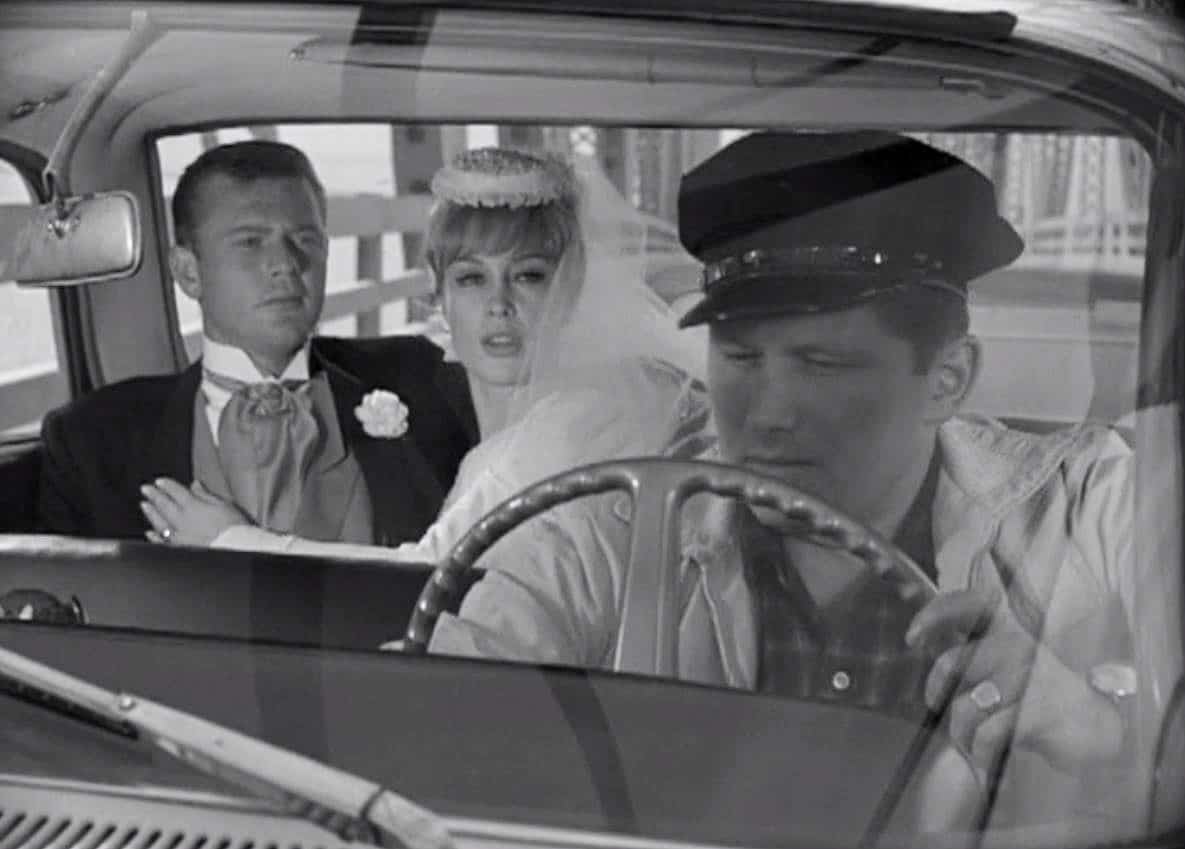
The penultimate episode of the early 1960s TV drama Route 66 ends with cynical protagonist Tod Stiles (played by Martin Milner) thrown from the top of the Sunshine Skyway Bridge into Tampa Bay. Will he survive and live happily ever after with his new bride Margo (Barbara Eden)? Cliffhanger!
Spoiler alert: Route 66 finished its four-year run on CBS with the next installment, in which Tod returns, his bones and internal organs intact, to exact revenge on the no-goodniks who’d tried to kill him. After he and his traveling buddy Linc Case (Glenn Corbett) set things right, Tod and Margo head off into the sunset to begin their new life together.

Corbett, left, and Milner
Both parts of this episode (Where There’s a Will, There’s a Way) were filmed in the Tampa Bay area in January 1964, with numerous recognizable landmarks. It marked the fourth time the Route 66 crew had been in the vicinity, using dozens of local residents as extras and preserving – through endless reruns, home video releases and streaming opportunities – a black and white snapshot of our area during the last days of the Kennedy administration and just beyond.
Gritty and realistic, Route 66 was created in 1960 by writer Stirling Silliphant and producer Hal Leonard, whose concurrent series Naked City used a similar anthology format. The two recurring characters – Tod (Milner) and Buz (George Maharis) – were philosophical but disillusioned young men traversing the country in a Corvette convertible, looking for truth, purpose and the meaning of life. And women.
Each episode found them in a different city, taking odd jobs and inevitably getting involved in some sort of trouble with the locals. (Interestingly, very few storylines took them along the actual east-west highway that gave the show its title). The Route 66 company, numbering around 60 people, spent half of each year on the road, on location. Silliphant, it was reported, re-wrote scenes and dialogue on a daily basis.
Maharis left the series midway through the third season, with Corbett hired to replace him.
And it was during the Corbett-as-Linc era that Route 66 meandered its way to this part of Florida.
The episodes
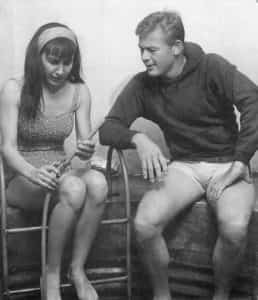
Bonnie Georgiadis teaches Milner about hose-breathing.
The Cruelest Sea of All (original air date: April 5, 1963). Tod and Linc arrive at Weeki Wachee Springs where Milner’s Tod, hired to scrape algae off the big underwater viewing window, meets a most unusual mermaid, Elissa, played by Diane Baker. She swims like a fish and can hold her breath interminably – and, out of water, she’s an adorable, wide-eyed naif. Tod falls in love; much passionate smooching ensues. But he doesn’t believe she’s anything more than a Florida gal with great lung capacity.
Bonnie Georgiadis had been working as a Weeki Wachee mermaid for a decade when Route 66 rolled up to the Hernando County attraction, Corvette and all. “I was asked to train Diane Baker and Marty Milner to do their underwater parts, how to hose-breathe, and how to clear their ears if they didn’t already know – and they didn’t,” she said.
On one of his deep dives for the cameras, Milner forgot to equalize his ears, and the resulting injury kept him out of the water for several production days. “He autographed a picture for me that said ‘If I had listened to you, I wouldn’t have a sore ear today,’” Georgiadis laughed. She still has it, although the ink has faded.
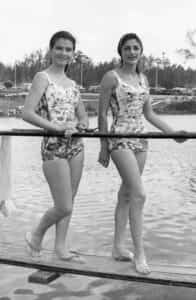
Diane Baker, left, was doubled by Weeki Wachee mermaid Genie Young.
Fellow mermaid Genie Young was hired to be Baker’s double, wearing identical bathing suits (this was before the swimmers performed in Spandex “fish tails”). While the actress herself appeared in the shallow-water close-ups, every one of Elissa’s deepwater dives was done by virtual lookalike Young.
Georgiadis left Weeki Wachee in 1990, after 37 years – first as a mermaid (she appears for a split-second in The Cruelest Sea of All, emerging from a giant clamshell), then as choreographer and show producer, finishing up her career as a falconer and manager of the bird area.
Among her memories, Route 66 stands tall. “It was a break from your daily routine,” she said, “and exciting to have these movie stars walking around.”

Between takes: Milner, Corbett and Baker.
Amongst diehard Route 66 fans, this episode – one of the few with even a hint of the mystical – is a favorite. As for the locations, it has stunning “backstage” views of the mermaid “theater,” looking very much as it still does today. And the relationship between Tod and Elissa clearly provided the blueprint for Ron Howard’s 1984 mermaid movie Splash.
Elissa: There is no love in the sea. There is no pain either. Here, you have love. But you have pain. I have felt it from you. This is the cruelest sea of all. But I will live here with you and I will be happy. If you believe me. I will show you. Tod, trust me. We will be back soon.
Tod: Elissa, who are you?
Elissa: The breathing air and the foam of the tides made a mingling with my mother, and I was born.
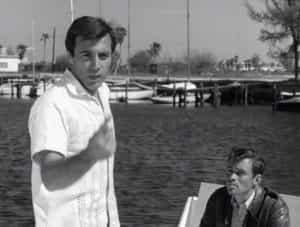
Alejandro Rey and Corbett, Davis Island Marina.
Peace, Pity, Pardon (original air date: April 12, 1963). The sinister shadow of Communist Cuba hangs over this episode, shot entirely in Tampa. Jai-Alai player Quiepo Varella, wanted by the Castro regime for helping escapees, befriends our heroes. They agree to help him get to a clandestine meeting, offshore under cover of darkness, with his brother, a violent revolutionary. Is it a trap?
Argentina-born Alejandro Rey, who would achieve notoriety, if not fame, on The Flying Nun a couple of years later plays the passion-fueled Quiepo, with Detroit actor Michael Tolan wearing a glue-on Castro beard, and faking a Spanish accent, as brother Largo.
A portion of this darker-than-usual installment takes place in the old Jai-Alai Fronton, where the actors are carefully positioned between the real players, the better to look like they know what they’re doing. There are some nice shots of Bayshore Drive as it appeared in 1963, and the original Davis Island Marina (where Tod and Linc have taken jobs). The old Twiggs Street courthouse and nextdoor Sacred Heart Church are in the background of an early scene.
Spoiler alert: This one does not end well.
Tod: How about you? Are you sorry?
Linc: No.
Tod: Why not? What got settled, tell me that?
Linc: Maybe nothing. Maybe everything.
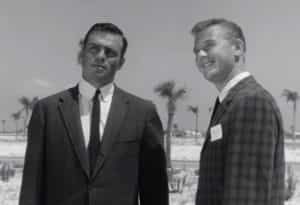
Tierra Verde, 1963.
But What Do You Do in March? (original air date: May 3, 1963). This is worth watching just for the long shots of Tierra Verde with nary a condo building in sight; it’s all dredged white sand, cabbage palm and scrub. Tod, in fact, has been hired to show potential homeowners around the undeveloped island while Linc works with a crew putting in seawalls. The plot is almost incidental – it involves two spoiled, competitive young rich girls who pit Tod and Linc against each other in a hydroplane race.
Ah, but the action centers around Port-o-Call, the resort co-owned and name-endorsed by bandleader Guy Lombardo, who performed regularly in the ballroom. Lombardo plays himself in a single clumsy scene. In real life, the dapper Canadian baton master also happened to be a former hydroplane champion; his own boats were used in the episode, as our two heroes speed along the bayway and fly under 1963-era traffic bridges. Great shots of St. Petersburg extras watching the “race.” Tod’s love interest (Midge) is played by Susan Kohner; Linc canoodles with Janice Rule (as Sid). Comedian Sammy Shore appears as Bix, a wisecracking boat mechanic.
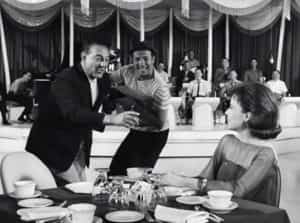
From left Guy Lombardo, Sammy Shore and Janice Rule at Port-0-Call.
Guy Lombardo’s Port-o-Call became many things in the decades following its eventual decline and sale; today, it’s the site of the Tierra Verde Marina Resort.
Sid: Well, I think it’s about time Florida waters get the recognition they deserve. That’s why I want you to help me set up a race circuit for Unlimiteds, right here in Tierra Verde.
Lombardo: But I’m afraid somebody else has the same idea.
Sid: How much prize money did Midge offer you?

Local crowds watch the filming at Tierra Verde.

Tod takes the plunge (a tuxedo-wearing dummy was used for this shot).
Where There’s a Will, There’s a Way (original air dates: March 6 and 13, 1964). Tod and Linc check into the old Causeway Inn, on the Tampa side of the Courtney Campbell Causeway, for what will turn out to be be their last adventure. Unfortunately, the two-part Where There’s a Will, There’s a Way can’t decide if it’s a drama or a comedy. Character actors Chill Wills, Roger C. Carmel, Nina Fochs and Patrick O’Neal guest in a convoluted story about the greedy siblings of a recently-deceased con man, with a radiant, pre-I Dream of Jeannie Barbara Eden as his only child. Daddy, for reasons never explained, put it in his will that no one inherits his money unless Margo marries Tod Stiles. Whom she has never met.
They meet cute and they fall in love, sharing a passionate kiss on the outdoor escalator at the old Busch Gardens brewery tour in Tampa. The wedding was filmed at Clearwater’s Episcopal Church of the Ascension (yes, Tod gets hitched, which will spell the end of the road for our cross-country bachelor buddies).

Roger C. Carmel and Martin Milner.
Even by TV standards, it makes no sense at all; the dialogue (especially between the siblings, each using a different bad foreign accent) is tedious and not terribly funny. Milner and Corbett invest very little dramatic energy; clearly they knew this was to be the last hurrah for Route 66, so why put any effort into it?
A third-act caper in which they disguise themselves as German naturalists is almost too painful to sit through.
Traffic on the two-lane Skyway was held up for 15-minute stretches as the crew shot Milner, Eden and the actor playing the bad guy at the apex (there are no other cars visible during this scene). The entire company then had to stand aside as traffic was allowed through for 15 minutes in each direction. Best guess: Additional scenes with Wills and Fochs seem to have been lensed on the Skyway’s northside fill causeways, which had little to no vegetation in 1964.
Tod: That Jezebel … you shoulda heard her – ‘I’ll explain everything later, darling’ … All the way down, with that water comin’ up to meet me, I was thinking of that farewell speech.
Linc: Shall I call a doctor? You might be all busted up inside.
Tod: Only my heart. The rest of me’s all in one angry piece.
Epilogue
Stirling Silliphant won an Academy Award in 1967 for writing In the Heat of the Night; he went on to pen the screenplays for the Irwin Allen disaster movies The Poseidon Adventure and The Towering Inferno.
While George Maharis enjoyed a short-lived singing career after leaving Route 66, as an actor he settled into character roles and guest spots. Glenn Corbett followed a similarly trajectory, although he and Roger C. Carmel are remembered fondly by science fiction fans for their guest roles on the original Star Trek series.
Martin Milner went on to greater TV fame as Officer Pete Malloy on Adam-12 (1968-1975).








Richard Berry
November 22, 2023at12:25 pm
Wonderful article, but there are seven more episodes in seasons 3 and 4of Route 66 filmed in Florida:
What A Shining Young Man was our Young Lieutenant, filmed in Tampa
Shadows of an Afternoon, filmed in Punta Gunta
Two Strangers and an Enemy, filmed in Cape Coral
Cries of Person close to One, filmed in Daytona Beach
Who in His Right Mind Needs a Nice Girl, filmed in Daytona Beach
This is Going to Hurt Me More than It Hurts You, filmed in St. Augustine
Follow the White Dove with the Broken Wing, filmed in St. Augustine
Dennis Stephens
August 6, 2022at1:35 am
Outstanding, Bill DeYoung !!
Deb Carson
March 9, 2021at7:50 am
Bill – what a fun read, enriched with local color and backstory. I’ve only seen one or two of these iconic episodes, will try and watch them all now because of your terrific article. Thanks!
Lawrence Clark
March 7, 2021at4:34 pm
About the best TV show ever.
JOHN DONOVAN
March 6, 2021at4:52 pm
Well researched and written; and a fun read.